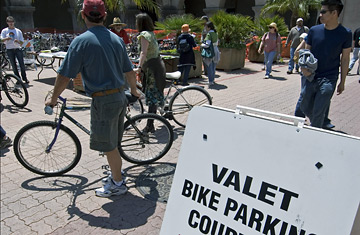
Bicycle valet parking in San Diego.
But that may be starting to change. Long Beach has pioneered the creation of commuter-biking hubs offering valet parking, showers and repair services, and other cities in California and elsewhere in the U.S. are beginning to take note. "The concept is growing fast and helping bike commuting move from an invisible subculture to an organized pursuit that's part of the fabric of everyday urban life," says John Case, a retired real estate financier who brought the Bikestation concept from Europe to Long Beach in 1996. Its popularity prompted public agencies and private groups in San Francisco, Berkeley, Palo Alto and Seattle have followed suit. The city of Santa Monica provides free valet parking on Sundays outside the farmer's market. The city of Chicago and McDonald's built their own Cycle Center in Millennium Park three years ago. And earlier this month, the mayor of Santa Barbara, home to 5,000 daily bike commuters, cut the ribbon on the newest Bikestation, an $80,000 self-parking garage inside an auto parking garage, offering showers, a changing area and a bathroom for fee-paying members. Bike parking centers in Pasadena, Santa Monica and San Diego also are in the works.
Some, such as the service in Santa Monica, are run by local governments hoping to encourage cycling to reduce CO2 emissions and ease traffic congestion, and are funded through parking fines and permit fees. Others are operated by advocacy groups and entrepreneurs.
The Long Beach facility shares a bustling downtown block with a municipal bus transfer station, shuttle vans and the last stop on the commuter rail line connecting the city with Los Angeles. It consists of two buildings: One unattended, houses up to 44 bikes whose owners pay $12 a month or $96 a year for round-the-clock access; the other, with 32 spaces, is staffed daily until 6 p.m., and offers repairs, rentals, accessories, snacks and riding lessons, as well as free valet parking. Although initially subsidized by the city, the fees and revenues now cover more than two-thirds of the annual $150,000 operating costs. "It's starting to become a nice little hub for cycling in Long Beach," says Dominic Dougherty, a certified bike mechanic who doubles as the Bikestation's valet attendant, social director and accessories shop operator.
Valet parking for bikes may seem like just another absurd Californian self-indulgence, but Bikestation advocates say the creature comforts help them promote cycling as an attractive alternative to driving. "In order to elevate the status of biking, we have to accomplish a cultural shift," says Andrea White, executive director of Bikestation, the non-profit group that helps cities set up the sites. "Facilities that are aesthetically pleasing with conveniences make people feel that they're part of something cool."
Adds Kent Epperson, director of traffic solutions for the city of Santa Barbara, who bikes to work four times a week, "A lot of people would like to bike to work, but don't because of the perceived impediments such as secure parking and the ability to shower and change after perspiring during the ride. [The station] will be an incubator for marketing bicycling as transportation."
For cyclists, safe parking is a godsend: Jean Gurnee, who rides her bike seven miles from home each morning and leaves it with the Long Beach station attendant says, "It's worth it to pay for someone to keep an eye on your bike because there's no way I would just leave my bike locked up some place outside. Besides, they're nice people who fill my tires with air when they get low."
And for valet attendant Dougherty, the facilities are harbingers of the future. "When all the gasoline runs out, the Priuses are going to be dead on the side of the road right beside the Hummers," he says. "But you'll still be able to get around on a bike."
